After my immensely interesting day exploring Tirana and learning about the history of Albania, I was heading south, to the popular seaside resort town of Saranda. My research had uncovered that there were frequent public buses covering the route every day, but that these mostly took the inland roads. I wanted to see the coastline of the Albanian Riviera on the way down, so I opted for the Riviera Bus, a more expensive option but one which would offer guaranteed coastal views (and a photo stop or two). This appears to be currently the only tourist minibus option on this route, and it only runs in each direction three times per week, so I booked online ahead of time to ensure that I would get a spot, which turned out to be necessary as the van was fully booked on the day. It was a lovely and comfortable drive of around five hours along the coast and up and down winding mountain roads, stopping at the Llogara Pass to soak up the views over the Riviera just after Vlores. Once we reached Saranda, the driver dropped us all directly at our various accommodation, which was much appreciated in my case as my holiday apartment was at the top of a steep hill (the price to be paid for the wonderful panoramic sea views across the bay and towards Corfu that I enjoyed from my balcony!).

The epic view from my balcony
I had heard and read mixed views on Saranda, with some suggesting that it had become too full of tourists in recent years and didn’t have very much to offer. It was certainly very busy – it seemed to be popular with domestic visitors as well as international travellers – and it was sometimes hard to find a spot on the beaches. While the sea was ideal for swimming in terms of the bottom sloping down sharply, offering deep water just a few metres out from shore, the beaches were pebble, not sand, and tough on the feet. However, even if Saranda wasn’t quite the beach mecca I had perhaps been hoping for, I still enjoyed relaxing by the sea, lapping up the views from my gorgeous (and very cheap) hillside apartment, and strolling along the promenade in the evening soaking up the buzz from the terraces of the restaurants and bars.


[On the topic of food, I didn’t find a huge variety of vegan offerings in Saranda. I didn’t come across anywhere offering a specifically vegan menu. However, I ate several times at Bar Restaurant Qesari (on the waterfront below the central area of Saranda town, just past Bar Limani) who made a delicious spaghetti and vegetable dish, and found that several other places along the promenade would also do vegetarian pizza without the cheese (though they looked at me very strangely when I requested it!) or a grilled mixed vegetable salad with bread (and a side of french fries usually featuring on the menu if you want to bulk it out further). I had a small kitchen in my apartment and I was able to purchase bread, fruit, vegetables, and other bits and pieces for breakfast and lunch in the grocery stores in the town.]
Saranda also proved to be an ideal base for some brilliant day trips within the south of the country. Gjirokaster and Butrint are two of the most well-known spots in this area, and it was easy to reach both.
Gjirokaster
I’d seen so many recommendations for this place – it seems to be a bit of a backpacking hotspot (I counted at least five hostels as I was wandering around) – that it had to be first up on my explorations. Gjirokaster is famous for several reasons; its fortress and Ottoman Old Town, which is a UNESCO World Heritage Site, and for being the birthplace of both Ismail Kadare, Albania’s most well-known contemporary author who, as I explained in my previous post, first put the idea of visiting the country in my head after I read the English translations of a couple of his novels, and of Enver Hoxha, the communist leader of Albania from the 1940s until his death in 1985. It’s also considered to be one of the best spots for souvenir shopping, with numerous bazaars in the streets of the Old Town.
A number of buses and minivans go to Gjirokaster from Saranda’s “Bus Station” – I use quotation marks because there’s nothing to suggest that it is a bus station; it’s just general knowledge that the buses leave from Rruga Flamurit, opposite the Friendship Park and right next to the Roman mosaic and archaeological remains of a 5th century synagogue (which randomly sit on show in the middle of the town. They’re pretty impressive!). I took the 8.30am Tirana bus (check with the conductor that it does stop in Gjirokaster first) and paid 300 lek for a fairly comfortable ride on an air-conditioned coach-style vehicle (no seatbelts though, so hold on along those bumpy mountain roads as you head inland!). As we pulled into the modern part of Gjirokaster around 90 minutes later, the conductor announced it for the handful of us who were leaving the bus here.

The mosaic and ruins in Saranda; the “bus station” is right here
The bus stopped at the foot of the hill on which Gjirokaster’s Old Town is built, and I had read to expect a bit of climb to reach it. My guide book and a number of the websites that I had looked at when researching my visit had quoted various descriptions of his birthplace from Ismail Kadare, who has written about Gjirokaster in several of his books, and my favourite referred to the steepness of the city; “certainly this was the only place in the world where if a passer-by fell, instead of sliding into a roadside ditch, he might end up on the roof of a tall house.” This came to mind as the busy roads and traffic of the modern city gave way to quiet, narrow paved streets lined with white houses which almost appeared to be stacked on top of one another as the path steepened, just as Kadare had written.

Once in the Old Town, I decided to head up to the fortress first. This is another steep climb in itself, so it was definitely a good idea to do it before the midday heat hit. The fortress, also known as Gjrokaster Castle, has a long and interesting history from the time that it was first built in the 12th century, and for a small entrance fee (200 lek) you can go in and see this for yourself.
As you might expect, the fortress played a defensive role during the Byzantine and Ottoman eras, and the city was built up around it. In the 1930s, King Zog turned it into a prison for dissidents; this function ceased in 1968, the same year that the first Gjirokaster National Folklore Festival (which continues today) was held there – allegedly the authorities felt that it wouldn’t sit easily with those attending the fortress to have a good time at the top to have people held in the cells below.

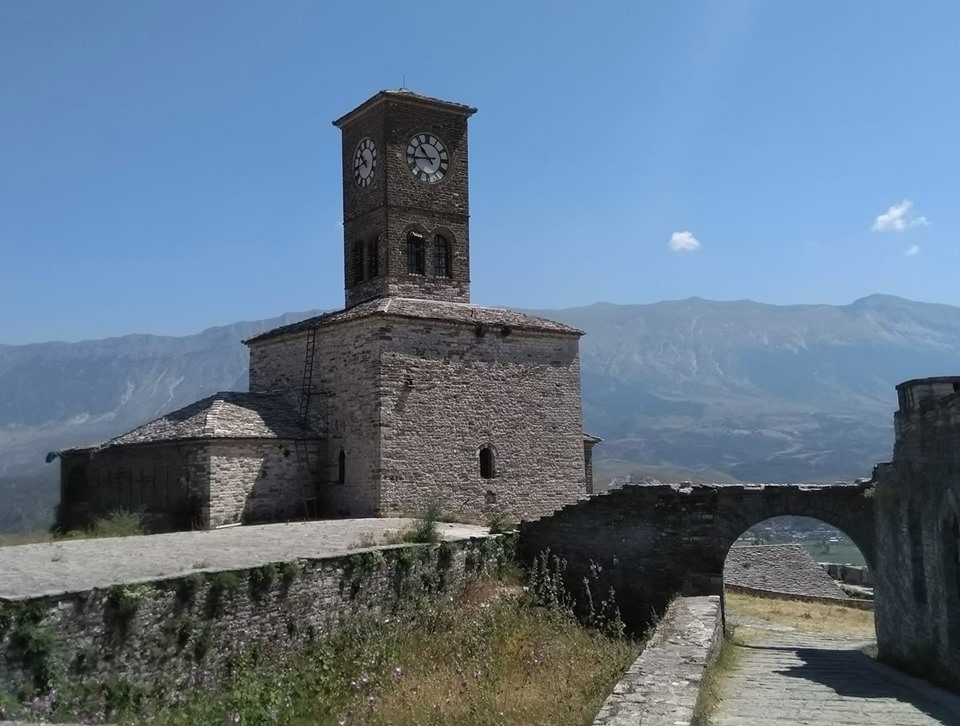

My favourite historical artifact in the castle was the rusty shell of an American fighter plane which sits in the grounds above the city. An information board next to it explains the contrasting narratives around how it came to be there after landing in Tirana during the depths of the Cold War in 1957; the US version (the pilot was “forced to land” after developing mechanical problems, and arrived back in the States a few weeks later), the Albanian government of the time’s version (it was an American spy plane sent as part of the plot to undermine the communist regime, captured by military forces and the pilot forcibly sent back to the US), and the likely truth – that the plane did develop technical issues, the pilot was given permission to land, and returned peacefully to the US as soon as he could, leaving his damaged plane behind. It’s a tangible example of how Albania related to the rest of the world during the twentieth century.


The views over the city and across to the nearby mountains from the top of the fortress were fantastic, and completely worth the climb. Looking down on the grey slabs of rooves across the Old Town, it was clear to see why Gjirokaster is known as the “stone city”.

Back down in the Old Town, I went for a wander. I found the house where Enver Hoxha was born, now the Ethnographic Museum, and I also managed to find the house where Ismail Kadare grew up; this one was trickier to locate, but luckily I ended up walking behind a small English-language tour group who appeared to be heading that way, so I sneakily followed!

The house where Enver Hoxha was born, now the Ethnographic Museum

The house where Albanian author Ismail Kadare was born
Even in the Old Town itself the streets climb up and roll downhill (it was easy to see why Kadare described the city as “breaking the laws of town-planning”!), so walking could be a slow task at times, with the sun now beating down on the stone walls and roads, but at every turn there was a lovely view or something pretty to photograph.


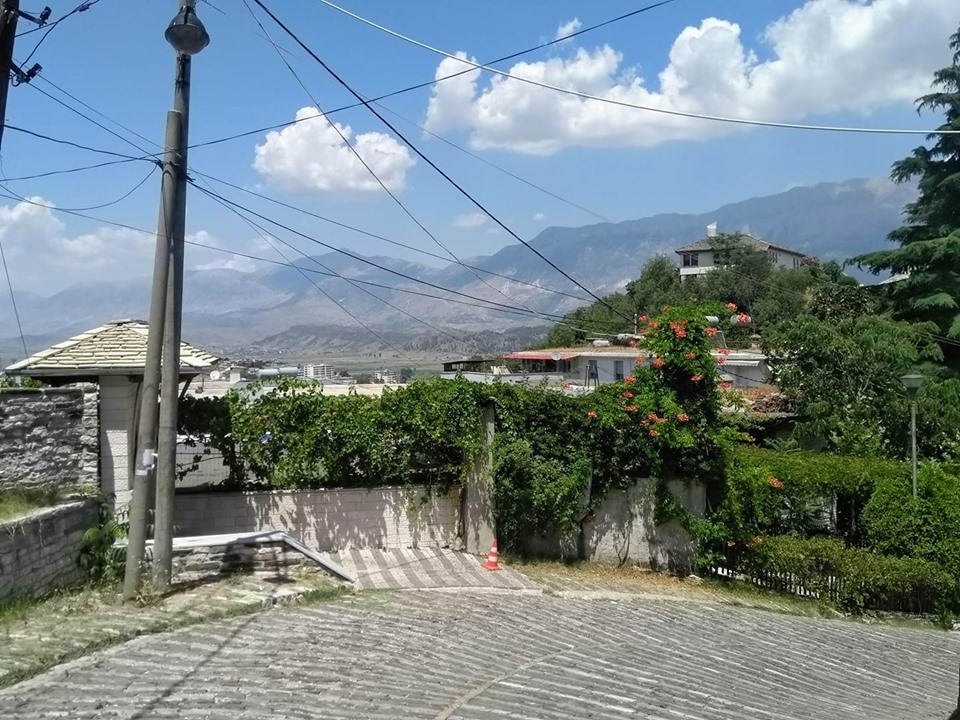

After ducking into a cafe for a simple but delicious lunch of grilled vegetable salad and chunky bread, I went for a walk around the bazaars to find some souvenirs. I was only buying my usual – postcards and fridge magnets- but there was plenty more on offer; locally made shawls, rugs, cups, bowls and jewellery, set out in enticing spreads outside the many stores on these shopping streets.


Souvenirs in hand and my phone full of photographs, I headed back down the hill to wait at the service station at the bottom where I’d read that I could pick up the bus to Saranda. This time it wasn’t a public bus, but one of the shared minivans which also run along this and many of the other popular routes. The price is the same, but there doesn’t seem to be much of a timetable, so I ended up waiting there for quite a while until, I think, enough people had turned up for the driver to decide to set off. We then had a couple of false starts, with the van going round the road a couple of times before leaving, and some seemingly heated conversations between the driver and some of the other passengers – everyone else was Albanian and so I couldn’t understand what was going on – so I’d suggest allowing plenty of time for your journey back, just in case this is a regular occurrence! The air-conditioning in the minivan then packed up, so the driver opened the door to let the air in as we swung around the mountain roads, again with no seatbelts – the trip back to Saranda was most definitely an experience!
Butrint
On my final day in Saranda I decided to pay a visit to the famous Roman ruins of Butrint. This is another UNESCO World Heritage Site in southern Albania. The Butrint National Park is just a 30-minute bus ride from Saranda, so it’s an easy half-day trip to see the stunning archaeological remains of the Roman colony set up in 44 BC by order of Julius Caesar.
There’s a lot of different information flying around online about the buses. I knew that I wanted to go early, to try to beat the tour groups who come over on day trips from neighbouring Corfu, and it seemed like the first bus of the day was at 8.30am (although the timetable posted at Butrint seemed to suggest that there was a 7.30 one too). I headed once again to the informal bus station in the centre of town, but rather than pulling onto Rruga Flamurit next to the mosaic, as the Gjirokaster buses do, the Butrint bus stopped at the bottom of the road, at the junction with the coast road Rruga Jonianet, so I had to do a little jog to make sure I caught it. It was already rammed full of people when I got on, so the online rumours of there being another bus stop further up, at the junction with the road leading down the port, appeared to be true. Again, a conductor came round collecting fares; 100 lek from Saranda to Butrint.
The bus dropped us off right outside the entrance to the ruins. A timetable posted there showed that it leaves at 30 minutes past every hour throughout the day, from both Butrint and Saranda.
It was just after 9am and there were number of people there already, but the ruins were still fairly uncrowded, and so there was plenty of opportunity to wander around and really take in the spectacular sight of what has been uncovered of the Roman colony. You can pick up a free map at the entrance, and there are information boards in every section explaining what you are looking at; the theatre, baptistery and city walls and gates are very well-preserved, and there are a few mosaics to be seen too. Beyond the settlement sits the blue waters of the lake and the greenery of the marshes, which provide some lovely views on the walk up to the acropolis at the top of the site.




The theatre


The baptistery
As well as some great photo opportunities (and, importantly, the only toilets available), the little fortress also offers a small museum which contains some of the busts, coins and other artifacts which have been uncovered during excavations at Butrint.


It took me around two hours to explore the whole site, which fitted in nicely with bus timings. As I waited for the 11.30am bus back, the tour groups were starting to turn up, so I think going first thing was most definitely the best plan.
On the way back I decided to get off the bus at Ksamil, about 10 minutes after Butrint on the way back to Saranda. Ksamil is another popular beach resort town, but I had read that the beaches were sandy, in contrast to the pebbly offerings of Saranda, so I had brought my bikini and towel along so that I could go and have a dip.
Finding a spot on the beach wasn’t easy – Ksamil was even more packed out, with mostly domestic tourists I think, than Saranda was – but I eventually managed to find somewhere to sit. The water was similarly perfect for swimming – clear and blue, and quickly deep – and the sand was a lot gentler on my feet. Despite the crowds, I enjoyed spending a few hours soaking up the beach life there.

The next day, my time in Albania was over. Rather than take the bus four or five hours back to Tirana to the only commercial airport in the country, I took the ferry over to Corfu to fly home from there. Seven days was nowhere near long enough to explore this beautiful, fascinating, welcoming country; it’s certainly a place to which I will return one day.
Enjoyed this post? Pin it for later!


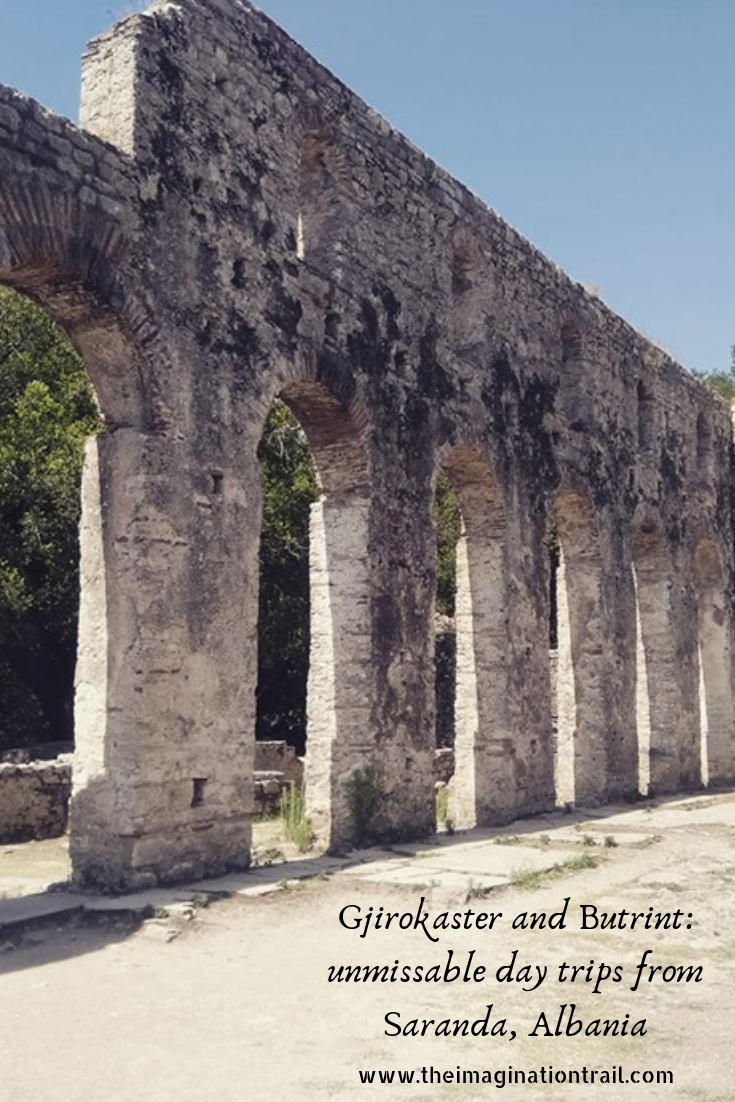
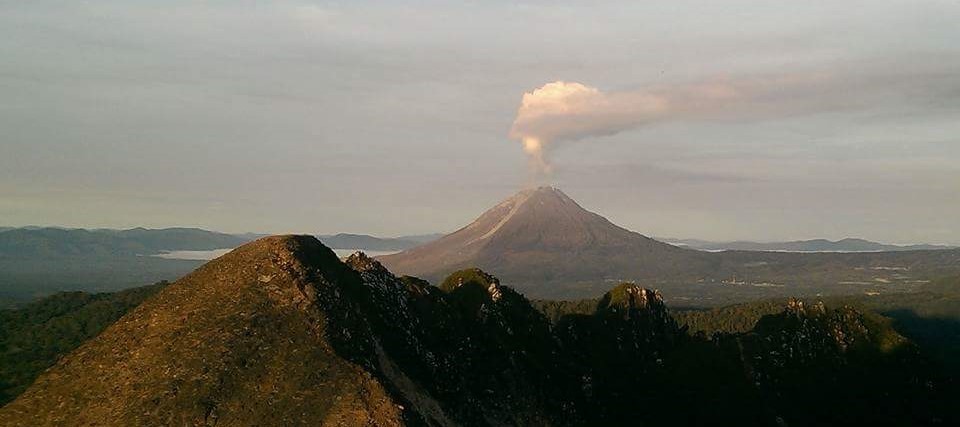




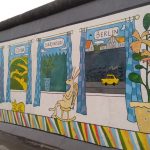


I did Butrint but you’ve made me want to do Gjirokaster. Can’t wait to explore! Thanks for the post!
The views from Saranda are incredible! I’ve not been to Albania yet but definitely saving this for when I do. Is there a specific time of year you recommend visiting?
The south of Albania has a Mediterranean climate, so for the hot beach weather you would want to visit in summer. I went in July, and the water was lovely and warm, but the beaches were very busy – next time I might aim for slightly earlier, perhaps June. I’m told that in winter businesses along the coast do shut down, so I’d definitely suggest it as a summer destination. Thanks for reading and commenting!
Great post! I’ve traveled a lot, but I had NO idea what Albania was like or even looked like. So much more of the world to explore!
Thanks for reading and commenting Amy! I know exactly what you mean…my list just keeps getting longer!
I’ve heard so many good things about Albania and this post just solidifies that! I really need to make a trip over there soon. The beaches look gorgeous, and that story about the plane is crazy!
Thanks for reading and commenting Kelsey! As you might have gathered from my posts, I’m another voice highly recommending Albania!
Amazing! I am heading over there mid-August and I am very excited! I’ve been to Gjirokaster already but I’m looking forward to going back and give my legs and glutes a nice workout 😀 Butrint is also on my list of places to visit and I’m glad to see it’s easy to reach from Saranda.
Did you feel comfortable leaving your belongings on the beach to go swimming in Saranda and Ksamil? I know I’ve felt safe doing that in Ohrid for instance, and I do it all the time in Belgrade but I’m wondering what’s your experience there?
Thanks for reading and commenting Marion! Yes, I did leave my stuff on the beach in Saranda and Ksamil…the beaches are full of sun-loungers and umbrellas to rent and so I tucked my bag under the lounger.